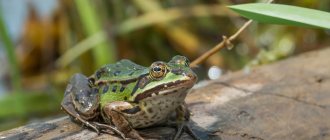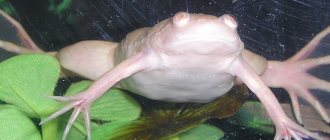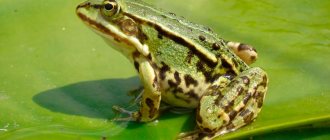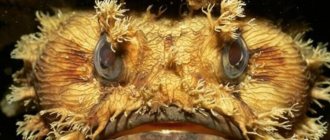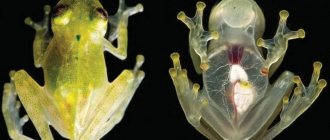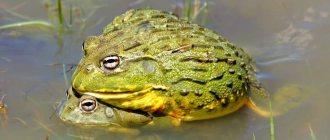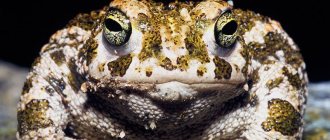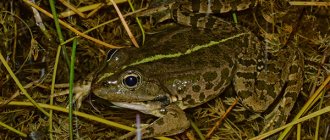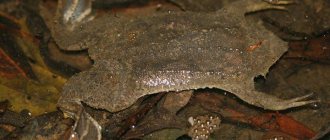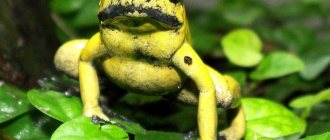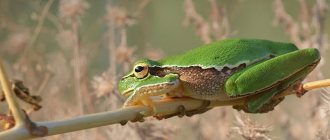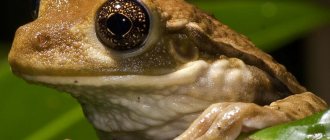Pointy-faced frog, or marsh frog (Rana arvalis) is the most common species of amphibian. It lives in a wide variety of areas, as well as in all the main green areas of the city, gardens, and parks. The general color tone depends on the weather, for example, on a sunny day the frogs become significantly lighter. Frogs are most active in the evening, but they can often be found during the day. It feeds on land on various invertebrates. This is the only species of tailless amphibians found in the tundra.
Appearance
The sharp-faced frog belongs to the group of brown frogs. The muzzle is slightly pointed. The tibia are 1.9-2.6 times shorter than the body. The inner calcaneal tubercle is high, 1.1-2.3 times shorter than the first toe of the hind leg, laterally compressed. The temporal spot is large, extends from the eye through the eardrum almost to the shoulder, gradually narrowing. There is often a light, sharply edged dorsomedial stripe that reaches the middle or end of the snout. The male differs from the female by the presence of nuptial calluses on the first toe of the front leg, a paired throat resonator and, during the mating season, a light blue body color (the female is brown or reddish-brown). The skin of the sides and thighs is smooth. On the back and sides of the frog there are dark spots 1-3 mm in size, which vary greatly in number, location and size.
Interesting facts about the animal
- Life expectancy reaches 11 years.
- The shells of frog eggs are coated with ranidine. It is poisonous to parasites.
- The animal is not adapted to life in a human apartment. If you are going to get such a pet, then prepare a terrarium or a small pool in advance.
- The average price of an amphibian on the market varies between 300-800 rubles.
- Thanks to their lungs, individuals can produce a loud voice in the form of peculiar sounds. A wide range for attracting the opposite sex is the merit of resonators and sound bubbles.
- In the Voronezh region there is a nature reserve in which various inhabitants live in swamps, lakes and rivers. People walking around the area are advised to watch their step to avoid stepping on the sharp-faced frogs.
- The amphibian's fertility is low. The maximum number of eggs is 3000 pieces.
- During sleep, the creature's vital processes slow down. Their pulmonary breathing stops.
- According to modern taxonomy, reptiles and amphibians have a number of common features, but these are completely different classes.
- The sharp-faced frog is not poisonous. However, it is not recommended to pick her up. This can cause the creature to die due to stress. For fishing it is better to use a net.
Nutrition/food
The sharp-faced frog hunts only for moving insects, instantly grabbing prey with a long sticky tongue. The diet depends on the habitat: beetles, spiders, fillies, bedbugs, caterpillars, mosquitoes, ants. The feeding areas of different frogs living in the neighborhood overlap. The size of the feeding area and the adherence of frogs to it is determined by its feeding capacity. If food becomes scarce or humidity conditions change, the marsh frog begins to migrate to other places. Movements occur gradually at a speed of 3-20 m per day, and not only feeding areas, but also biotopes can change. Such movements can take place over several weeks or over two or more seasons.
Where does it live?
This type of amphibian is distributed in the northeastern part of Europe - France, Sweden and Finland, as well as in its southern part - to the coast of the Adriatic Sea and eastward - to the Urals. It can also be found in Siberia (both Western and Central), as well as in the northern part of Kazakhstan. In the eastern direction, its habitat reaches Yakutia, right up to the Baikal region.
The marsh frog is the only species of amphibian that lives in the tundra.
This amphibian is found in forest, forest-steppe and steppe zones, found in meadows, swamps and arable lands, even in semi-deserts and mountainous areas - but not higher than 800 m above the sea.
This species of amphibian is rightly called the most drought-resistant among other frogs - it can be found in many different places.
The sharp-faced frog can be seen in fields, in parks, on roads and near homes - but this amphibian prefers to live in deciduous forests (usually alder, oaks and birches), as well as floodplain meadows.
But, like any amphibian, this frog is not able to exist without the presence of nearby water spaces suitable for reproduction.
Behavior of the sharp-faced frog
The marsh frog lives on land most of its life and breeds in the water in early spring. Coming onto land, it selects a suitable area, usually with an area of 200-300 sq.m., in which to hunt and which it protects from relatives. Lives in this area until winter. It goes hunting in the evening and actively feeds between 20-22 hours. After midnight, activity begins to decline, and from 4 a.m. to 6 p.m., activity is low. During inactive times, it hides at the bottom of reservoirs; in summer it hides in wetter places (under fallen trees, in stumps, etc.). The sharp-faced frog goes to winter from the beginning of September to the end of October. The duration of hibernation is 165-170 days. Young frogs go to winter later than adults. It overwinters on land in groups: in holes covered with leaves, in heaps of leaves and brushwood, in rodent burrows, etc.
Habitats
Forest and forest-steppe zones are the main places where this species of frogs lives most en masse. In the mountains, they can occasionally be found in Altai, at an altitude of no more than 2140 meters above sea level, in the Carpathians, up to an altitude of 987 m. They live almost everywhere, choosing both wet and dry areas.
In broad-leaved and mixed forests they prefer to occupy edges and clearings. They like to settle in floodplains, swamps, overgrown ravines, and meadows rich in herbs. It is not uncommon to encounter this amphibian in agricultural fields, vegetable gardens, and even in city parks and squares.
Reproduction
Reproduction and early development occur in stagnant bodies of water (lakes, ponds, swamps, puddles, ditches). It comes to spawning reservoirs from a distance of up to 1 km in 3-4 days. The sharp-faced frog, having arrived at the pond, immediately begins to reproduce. Males gathered in a reservoir to breed form large aggregations. Males spend a long time in reservoirs, lying in wait for females who have not yet spawned eggs when they come to the reservoir. Individual males can remain in the reservoir for up to 20-25 days. Females not only come to the reservoir later than males, but also, having laid eggs, immediately leave it. The water temperature at which egg laying begins is 12.0-14.8°C. Eggs are laid both day and night, in shallow, well-warmed places with a depth of 5-30 cm. Females lay eggs in the form of lumps near the shore. The eggs lie at the bottom for about a day, then float to the surface. In one place there is often a huge amount of eggs laid by many females.
Red Book
The sharp-faced frog is an order of magnitude inferior in numbers to its competitor, the grass frog, and back in 2000 (until 2010) it was impossible to observe more or less impressive concentrations of this species of amphibian during the spawning period.
The marsh frog is a habitual inhabitant of forest and meadow natural biotopes, as well as their other species. On the territory of Moscow, it is significantly more capable of feeling the impact of the urban environment than the grass frog. This is primarily due to the fact that this species chooses heated reservoirs for breeding, and such natural areas are located, as a rule, in actively visited places - edges or clearings.
By 2001, the condition of this species was deplorable - if we take into account the territory of Moscow - and it literally disappeared in many of its regions, and in others it is in critical condition.
Development of the sharp-faced frog
The length of tadpoles is 5-8 mm, before metamorphosis 35-48 mm. A newly hatched larva has barely defined body parts. The head is separated from the body by a slight interception, and the posterior end of the embryo is extended into a long tail. The tail is surrounded by a wide fin running along the back of the larva. Tadpoles are colored black. In the mouth area, with a magnifying glass, you can see three rows of keratinized teeth. Soon after hatching, external gills develop and are of considerable length. In the first half of larval development, before the appearance of the limb buds, when the processes of formation of various organs are intensively underway, the tadpoles of the sharp-faced frog increase by 0.4 mm per day. The entire larval development takes on average 60-65 days, but in exceptional cases it can last up to 120 days. Duration of metamorphosis is 4 days. Tadpoles eat cladocerans, diatoms and other algae, higher plants, detritus and a small number of aquatic invertebrates. They feed around the clock, but form food aggregations only during the day. During the period of metamorphosis, nutrition stops for a short time and is resumed before the end of the metamorphic menopause. Newly metamorphosed fingerlings prey on ticks, springtails, and other small arthropods.
Notes on taxonomy Rana arvalis belongs to the group of brown frogs. In the past, it was combined with R. temporaria (C. Linnaeus described both species of frogs under the name R. temporaria). Although these are separate species, there are reports of mixed pairs and even natural hybrids. The reality of such hybrids requires biochemical verification, and their fertility is questionable. Although R. arvalis has long been considered a good species, there have been problems identifying this frog in the southwestern part of its range in the USSR due to the fact that the long-legged individuals of R. arvalis can be confused with the frog (Rana dalmatina). This confusion has led to reports of the presence of R. dalmatina far beyond its range in the USSR: in the west of European Russia, in Ukraine, Belarus and Moldova - i.e. in those regions where long-legged individuals of R. arvalis are more common.
Morphology Morphology. L = 36-80 (up to 97) mm. The muzzle is more or less pointed. Males have internal throat resonators. The tibia are 1.9-2.6 times shorter than the body. If the lower legs are positioned perpendicular to the longitudinal axis of the body, the ankle joints slightly touch or overlap. If the hind leg is extended along the body, the ankle joint usually reaches the eye, nostril, end of the muzzle, or even extends somewhat beyond the end of the muzzle. The inner calcaneal tubercle is high, 1.1-2.3 times shorter than the first toe of the hind leg. The skin of the sides and beler is smooth. Gray, light olive, yellowish, brown or reddish brown above. There is a glandular /\-shaped spot on the neck. On the back and sides they have; spots of 1-3 mm, which vary greatly in frequency, location and size. The temporal spot is large. A light dorsomedial stripe is often present, with distinct edges, often reaching the middle or end of the snout. The belly is white or yellowish without a pattern or with pale, brownish or grayish spots on the throat and chest. The male is distinguished from the female by the presence of nuptial calluses on the 1st toe of the front leg, a paired throat resonator and, during the mating season, a light blue body color (while the female is brown or reddish-brown).
The fingerling immediately after metamorphosis has L = 7.5-31 mm. In the tadpole, immediately after hatching, L + L.cd = 5-8 mm, before metamorphosis, 35-48 mm; dental formula 1:2+2/1+1:2 or 1:1+1/1 + 1:2.
In a clutch there are 315 - 3080 eggs, laid in one, less often in two, lumps with a diameter of 8-15 cm. The diameter of the egg with shells is 7 - 8 mm. without shells 1.2-2 mm.
Karyology Diploid set of chromosomes 2n=24, NF=48.
. Distribution
The species inhabits a wide area from southern Sweden and Finland to France, southeastern Europe and Siberia. The northern border of the range runs from northern Karelia through the north of the Arkhangelsk region to the Polar Urals, the river. Yenisei and Yakutia. The northernmost point of the find in the European part of the USSR is the Kandalaksha Nature Reserve (66°35′ N, 33°13′ E) in the Murmansk region. Further, the border of the range runs east approximately along the line: Arkhangelsk region. (Pinezhsky Nature Reserve: 64°35′ N, 43°03′ E - south of the Kanin Peninsula, delta of the Chesha River - Nenechky Autonomous Okrug, Tobseda village: approx. 68°30′ N ., 52°30′ E) - Vorkuta (67°29′ N, 64°00′ E) - Tyumen region. (Yamalo-Nenets Autonomous Okrug, Kharvut trading post on the Khadyta-Yakha river: approx. 67°40′ N, 70° E) - Krasnoyarsk Territory (Taimyr Autonomous Okrug, Khantayka River basin: approx. 68 °N, 87°E). Further, the border runs south-southeast from the river. Yenisei to the river Chuna in the Krasnoyarsk Territory and Irkutsk Region. (Boguchansky district, Chunoyar village: approx. 58°N, 96°E) and to the city of Irkutsk (52°19′N, 104°18′E). The sharp-faced frog inhabits the valleys of the river. Lena and its tributaries Peleduy, Nyuya and Bolshoy Delgey from Irkutsk to the northeast to the village of Sanyyakhtakh in Yakutia (60°40′N, 124°E). A more northern find, the village of Et-Kyuel on the river. Namana (approx. 61°N) needs checking. Also recorded in the Olekminsky Nature Reserve (58°45′ N, 122°20′ E). From the river valley Lena in the Irkutsk region. (Kirensk village: 57°45′ N, 108°04′ E) the border of the range runs south to the northern coast of the lake. Baikal in the area of Baikal xp. South of Baikal, the frog is distributed from the river. Irkut (approx. 51°30′N, 102°E) to the northeast along the southern coast of lake. Baikal to the Barguzinsky Nature Reserve (54°23′ N, 109°05′ E).
The southern border of the range runs approximately along the line: Odessa region. (Kiliya district, Danube Plavni reserve: 45°02′ N, 29°42′ E) - Nikolaev region. (Chichikleya river: approx. 47°30′ N, 31° E) - Kherson (46°38′ N, 33°37 E)' - Zaporozhye region. (Zaporozhye Reservoir) - Donetsk region. — Rostov region. (Taganrog: 47° 12′ N, 38°55′ E - Azov - Rostov: 47° 13′ N, 39°42′ E) and to the northeast to the south of the Volgograd region. Further, the border runs east approximately along the line: Uralsk (51° 13′ N, 51° 22′ E) - Aktyubinsk (50° 16′ N, 57° 12′ E .d.) - Turgai region. (Tusum sands on the Turgai river: approx. 48-50° N) - Tselinograd region. (Kurgaldzhinsky reserve: 50°03′ N, 69°14′ E) - Karaganda region. (Karaganda: 49°53′ N, 73°05′ E - Karakalinsk) - district of Semipalatinsk (50°27′ N, 80° 14′ E ). Further, the border turns south to the city of Ayaguz (47°58′ N, 80°26′ E) and into the Taldy-Kurgan region. (west of Lake Alakol, Uch-Aral village: approx. 46°20′ N, 80°40′ E).
The sharp-faced frog inhabits many islands in the Baltic Sea (Vormsi, Saaremaa, Hiiumaa), the White Sea (Great), on lakes (for example, Pokoinitsky Kamen on Lake Baikal, Kizhi on Lake Ladoga, etc.) and the rivers Dnieper, Don, Oka , Mesha, Kama, Ob, etc. Indication of the presence of a view of the island. Solovetsky in the White Sea were not confirmed by our research. The range of inhabited altitudes is 0-2140 m above sea level.
Subspecies and variability Currently, 2 subspecies are recognized, both found in the USSR.
Rana arvalis Nilsson, 1842. The subspecies inhabits the main part of the range.
Rana arvalis wolterstorffi Fejervary, 1919. In the USSR, the subspecies is known from the Transcarpathian Plain, but there is information about finds in Moldova and the Danube Delta. It differs from the nominate subspecies in its larger size, slender body, longer hind legs, longer tibia relative to the thigh and longer tibia than the forelimb.
Rana arvalis is a very variable species and it is difficult to determine its subspecies based on morphometric characteristics. Individuals from the Altai Mountains, on the basis of their shorter tibiae and large internal calcaneal tubercle, were for a long time considered to be a separate subspecies, R. arvalis altaica. However, similar frogs were later found in other parts of the species' range. Even in Siberia, some frogs have characteristics intermediate between the nominative and Altai forms. Consequently, morphological boundaries cannot be established between them. Short-legged frogs are also described from the north of European Russia (Arkhangelsk region), initially as R. arvalis altaica natio issaltschikovi. After some time, their rank was raised to subspecies. However, later the validity of the subtype was not confirmed. In the Urals, the relative length of the legs of frogs. increases to the north, but the northernmost populations (which live in the forest-tundra and tundra zones) are represented by short-legged individuals. The latter are also known from Western Siberia and, as already indicated, from Altai.
Long-legged frogs from European regions are still considered a separate subspecies R. arvalis wolterstorffi, which is believed to live only in Western Ukraine and Moldova. However, long-legged individuals, identified as R. arvalis wolterstorffi, were also found far from these regions - namely, in the valley of the river. Dnieper, near the city of Kharkov and in the lower reaches of the river. Don in Rostov region. Moreover, some populations have an intermediate state of the diagnostic trait; both forms, as well as R. dalmatina (morphologically very similar to R. arvalis wolterstorffi (see below) coexist in the Carpathians. This does not fit well with the traditional view of R. arvalis wolterstorffi as a good subspecies. In fact, it may not be a subspecies , since between it and the nominative form there is neither a clear geographical isolation nor a morphological hiatus. However, I conditionally designate R. arvalis wolterstorffi as a subspecies until a comprehensive revision of the variability of R. arvalis. Thus, the difficulties in determining the subspecies of R. arvalis are associated with overlapping values of diagnostic characters of different forms, the presence of “transitional” morphotypes and clinal variability.
The polymorphism of dorsal coloration is also significant. It reflects parallel variation in different frog species and has no taxonomic significance. Almost all morphs known in brown frogs of the USSR fauna are also found in populations of the sharp-faced frog. The frequency of occurrence of these morphs varies across populations and even generations within the same population depending on local conditions, weather fluctuations, etc. It also varies by biotopes, geographical locations and altitude above sea level, although there are no clear geographical patterns here. For example, the frequency of occurrence of the striata morph in adult frogs increases north of the Ural Mountains. At the same time, in the city of Yekaterinburg (Middle Urals), the occurrence is higher in highly urbanized areas. The increase in the frequency of this striped morph in the city may reflect the higher adaptability of individuals with this genotype to unfavorable environmental conditions. The striped morph is also known to reach sexual maturity earlier and have a shorter lifespan than the striped morphs in the same geographic locations. On the other hand, the burnsi morph matures more slowly, which may also affect its proportion in different age classes.
Biotopes and abundance Biotopes and abundance. The sharp-faced frog lives in the zones of tundra, forest-tundra, forest, forest-steppe and steppe. In Europe, it inhabits generally drier and more open places than the grass frog (Rana temporaria), including forest edges and clearings, swamps, meadows, fields, bushes, gardens, etc. In Siberia, it lives mainly in open swamps. It penetrates into the tundra and steppe along with woody vegetation, mainly along river valleys. At the southern and northern limits of its distribution - in the tundra, forest-steppe and steppe, the sharp-faced frog stays near bodies of water: rivers, lakes, etc. In the south, frogs migrate considerable distances over land only in wet spring. Reproduction and early development occur in stagnant bodies of water (lakes, ponds, swamps, puddles, ditches) with an area of approximately 2–3 to 15,000 sq.m. and depth 10 – 200 cm.
The sharp-faced frog is one of the most abundant species of amphibian fauna of the USSR. In the land biotopes of Belarus, the average population density is 250-350 individuals/ha. Local density may be higher: for example, in reservoirs per 1 sq.m. sometimes there are 15-20 individuals. In the forests of central European Russia, the abundance of individuals per hectare varies from zero to several hundred. Here, the sharp-faced frog prefers more open biotopes than the grass frog, and to the north it is less common than the latter, while to the south and southeast this proportion gradually changes in favor of R. arvalis, and in the south of the sympatry zone the latter is already much more numerous. The ratio of numbers of both species varies from year to year, and in some places the predominance of one or another species alternates.
In Western Siberia, the sharp-faced frog inhabits various biotopes from the subzone of shrubby subarctic tundra to the steppe zone. In shrub tundras it lives in sedge bogs and lichen-sedge-fur tundras. In forest-tundra open forests it is already abundant along rivers and in complex hilly swamps, in the northern taiga - in swamps of floodplains of large rivers and meadows alternating with willows, while in others it is several times less. It is very numerous and is found everywhere in the middle taiga, where it prefers lowland swamps and other floodplain biotopes, pine forests and forested lowland swamps. In the subzone of the southern taiga, the sharp-faced frog reaches its maximum abundance on litter in the floodplains of large rivers. To the south, starting with subtaiga forests, it becomes less and less. In this subzone, the species prefers open sedge-reed bogs and, to a lesser extent, non-floodplain forested swamps and meadows, alternating with willows and birch-aspen copses in the floodplains of large rivers. In the northern and southern forest-steppe, the frog is most abundant in forested and open lowland sedge-reed bogs, meadows, meadow steppes and rafts of fresh lakes. As noted above, in the steppe zone the sharp-faced frog stays mainly near the water. Thus, in Western Siberia, R. arvalis generally prefers non-floodplain open lowland swamps and floodplains of large rivers, and in the forest-steppe and steppe - swamps and rafting lakes. The number of young of the year immediately after metamorphosis depends on the number of eggs in the reservoir. When this value exceeds a certain critical value (which depends on the conditions of the reservoir), the number of underyearlings decreases compared to the initial maximum value. This may indicate the presence of density-dependent regulation in groups of underyearlings. Density-dependent regulation is also important in conditions of high density of larval groups, where there are sometimes several hundred tadpoles per liter of water. However, the characteristics of the biotope and fluctuations in weather and climate seem to have a stronger influence on the dynamics of populations of the species as a whole
Thermobiology and activity cycles Rana arvalis in European regions is probably a more thermophilic species than the sympatric R. temporaria. It is often found in warmer, drier areas. Active adult individuals are sometimes found at air temperatures of +25-30°C. Wintering ends at air temperature 0 - +16°C and water temperature +2-6°C. Wintering is preceded by approximately equally low temperatures, 0 - +4°C. The breeding characteristics of the sharp-faced frog show that even during this period it prefers higher temperatures than the syntopic grass frog. For example, in Moscow, R. temporaria usually reproduces at a water temperature of +3-10°C, and R. arvalis at +10-15°C. As a result, the latter lays eggs at a later date (see below). Embryonic development in the European part of the USSR occurs at approximately the same water temperature as that of the grass frog; the upper limit is approx. +20°C. Short-term freezing of eggs when frost returns does not cause their death.
Tadpoles of different developmental stages prefer water temperatures of +19.6-26.5°C, although at the northern limit of the species' distribution they develop at lower average temperatures. As tadpoles develop, their preferred temperatures become higher and their range narrower. It depends on the acclimatization of the larvae to different temperature conditions. Age-related differences in tadpole temperature choice may lead to partial segregation of large and small individuals.
The diurnal activity of the sharp-faced frog is similar to that of the grass frog, but active individuals of R. arvalis are found more often during the day than R. temporaria. Cavities in the soil, under the roots of trees and shrubs, etc. are used as shelters. They winter mainly on land: in rodent burrows, pits, and piles of leaf litter. During severe and snowless winters, mass mortality of sharp-faced frogs occurs in land wintering grounds. Some individuals spend the winter in streams and swamps. Wintering grounds can be located up to 1 km from the nearest breeding site. Up to 60 frogs can winter in one place. Wintering takes place from September-November to March-June (usually April-May), depending on latitude and altitude. The earliest appearance (March) and latest disappearance (late November-December) occur on the plains in the south of the range, whereas the latest appearance (June) and the earliest disappearance (September) are in the Polar Urals. Thus, the wintering period takes from 4 to 9 months. per year. In the central part of the range, in the Oksky Nature Reserve, single individuals were found even in December, when the average air temperature dropped below -10°C. Frogs were observed crawling through the snow.
Reproduction Spawning occurs in March-June, usually a few days after the end of wintering. Males form mating choirs. The mating call of the male resembles a barking or gurgling sound. Pairs are formed randomly. The age structure of the adult population as a whole and age differences in the spatial distribution of frogs influence the age composition of breeding groups. The latter varies from year to year depending on the number of individual generations. Amplexus axillary. “Chains” of one female and one male in amplexus are observed. Mixed pairs of R. arvalis and R. temporaria are not uncommon, with male grass frogs more often clasping females with their sharp snouts than vice versa. Sometimes a male R. arvalis and a male R. temporaria clasp the same female R. arvalis. In other cases, excited males of R. arvalis grasp small R. ridibunda, the corpses of R. temporaria, or individuals of their own species; Such pairs sometimes exist for 24 hours. In general, males spend more time in the water than females. The total duration of reproduction within the reservoir is 3-28 days. Eggs are laid both day and night, in shallow, well-warmed places with a depth of 5-30 cm. The spawning peak of the sharp-faced frog usually occurs later than that of the grass frog in the same body of water. In addition, R. arvalis prefers to breed in more open and shallow (i.e. better lit and warmed) water bodies. These features may contribute to reproductive isolation of both species. However, interspecific hybrids have been described (see above). The sharp-faced frog is characterized by group spawning; clusters of eggs can number more than a hundred clutches and cover an area of up to several square meters. As noted above, in clusters of eggs the embryos are better protected from predators and sharp temperature fluctuations in the spring.
The behavior of males defending clutches has been described in frogs from the European part of Russia and Ukraine. Like the grass frog, the number of clutches laid in a reservoir, although it varies from year to year, is specific to the reservoir. From year to year, eggs are deposited in approximately the same places in the reservoir. Changes in the plant community can lead to a shift in spawning either to other parts of the same reservoir or to another reservoir, depending on the characteristics of the microbiotope: temperature, depth, composition of the plant community, etc.
Development Embryogenesis lasts 3-17 days, larval development - 39-81 days. (up to 120 days), depending on temperature and other factors. Metamorphosis occurs in different areas in June-October. The total duration of development before metamorphosis is reduced in the north and south of the range. At the same time, the duration of larval development varies among reservoirs from 47 to 118 days. even within the same population. In addition, the duration of development and the size of individuals during metamorphosis vary from year to year, because are largely determined by environmental factors. Embryos in clutches laid later in the season develop faster than in clutches laid earlier in the same body of water. Larvae tend to form large aggregations in warming shallow waters. Such accumulations can remain in place or move throughout the body of water. The duration of their existence during the day probably depends on the biotope and geographical location. In the evening, the aggregations become less dense and the tadpoles migrate to depth. The formation of such accumulations is associated with the selection of warmer water (see above). In addition, the temperature in dense accumulations is 1-2°C higher than in the surrounding water on cloudy days and 2-3°C lower on sunny days. In many natural larval aggregations, a “cluster effect” is observed. It leads to a density-dependent acceleration of the growth and development of larger tadpoles and a retardation of the growth and development of small ones. However, there is no clear relationship between the initial growth rate of an individual with its size before metamorphosis and the duration of larval development. The relationship between growth rate and population density varies across egg clutches and development stages. Density does not directly affect the survival of larvae, but it does affect the likelihood of successful metamorphosis, because Faster developing tadpoles more often manage to complete the transformation, while the “prolonged” tadpoles die in drying up water bodies.
Reproductive phenology also influences the development and mortality of tadpoles. As experiments have shown, at low population densities, larvae hatched from early and late laid clutches develop almost identically. However, at high densities significant differences appear. Tadpoles hatched from late-laid clutches have much higher mortality and lower rates of growth and development. They metamorphose into much smaller fingerlings and have lower energy reserves. This may be the reason for their lower survival rate. However, in good living conditions, compensatory growth occurs, which allows them to reach the size of individuals from early clutches. But this compensatory growth occurs quite rarely, and more often the growth rate is not related to the size of the tadpole after metamorphosis. The variability in the duration of the larval period within the offspring of one pair of frogs is comparable or even exceeds the intrapopulation variability in this parameter. Every year, each body of water produces frogs of more or less similar size, because a set of factors typical for this particular body of water is at work.
Sexual maturity is reached at 2–5 years of age. On average, females mature later and live longer than males. Both parameters are determined genetically. Frogs with a light dorsomedial stripe (striata morph) mature earlier and also die earlier. In general, the sharp-faced frog lives longer in the tundra and in the mountains (Altai), where individuals are usually 8–9 years old. To the south (for example, the plains of Ukraine, Belarus, the Moscow region and the Southern Urals) it lives less and individuals older than 5 years are rare. These geographic differences are similar to those of R. temporaria and are associated with different lengths of the active season (2-2.5 months in the north and mountains versus 4-6 months in the southern plains). The maximum known life expectancy is 11 years.
Diet The frog tadpoles eat Chlorophyta, Cladocera, Diatomeae and other algae, higher plants, detritus and a small number of aquatic invertebrates. They feed around the clock, but form food aggregations only during the day. These clusters differ from clusters that perform the function of thermoregulation. During the period of metamorphosis, nutrition stops for a short time and resumes before the end of the metamorphic menopause. Newly metamorphosed fingerlings prey on Acarina, Collembola and other small arthropods. In general, the composition of food and its age-related changes in the sharp-faced frog are similar to those in the grass frog. Adults consume mainly terrestrial prey. Aquatic invertebrates (Gastropoda. Dytiscidae, etc.) are eaten less frequently and, as a rule, irregularly. There is a “Marriage Fast”.
The razor-snouted frog plays an important role in some ecosystems. For example, in the mixed forests of Western Siberia, a frog population (consisting of approximately 90,000 individuals, or 190-200 kg of biomass) in summer consumes 55-60 kg of invertebrates per day from an area of 6 square meters. km. Due to age-related changes in diet, different age classes have different effects on invertebrate populations. In addition, different groups of invertebrates experience different pressures from frog predation due to the selective feeding of the latter. For example, Mollusca, Orthoptera, Homoptera, Coleoptera and Lepidoptera larvae are eaten with high positive selectivity, whereas Aranei and Hymenoptera are eaten with almost no or negative selectivity. Food selectivity changes with age. For example, young frogs prefer small prey (Homoptera) more strongly than adult frogs, while the situation with relatively large Orthoptera is the opposite. Even within the same prey group (e.g., Carabidae, Staphylinidae, Curculionidae), young of the year eat smaller individuals than adults.
Natural Enemies, Parasites and Diseases The frog's eggs and tadpoles are eaten by R. temporaria tadpoles, which hatch earlier. Cannibalism has been observed in the form of adult-younglings, larva-larva and larva-egg. Adults and young of the year are eaten by fish (Perca fluviatilis, Esox lucius and Lota lota), green frogs (Rana lessonae and R. ridibunda), snakes (Natrix natrix and Vipera berus), birds (Anas platyrrhinus, Ardea cinerea, Botaurus stellaris, Ixobiychus mimitus, Ciconia ciconia, C nigra, Plegadis falcinellus, Chlidonias nigra, Larus ridibundus, Lanius excubitor, L. cristatus, Tetrao urogallus, Corvus corone, C. frugilegus, Pica pica, Pandion haliaetus, Aquila pomarina, Falco vespertinus, Milvus korschun, Circus aeruginosus, Buteo buteo, Butastur indicus, Pernis apivorus, Bubo bubo) and mammals (Sorex araneus, Talpa europaea, Desmana moschata, Erinaceus europaeus, E. auritus, Lutra Intra, Maries martes, Meles meles, Mustela colonocus, M. erminea, M. eversmanni , M. lutreola, M. nivalis, M. putorius, M. vison, Nyctereutis procyonoides, Neomys fodiens, Rattus norvegicus, Cricetus cricetus, Eutamias sibiricus and Sus scrofa). This list shows that the frog is eaten not only by carnivorous mammals, but even by rodents and wild boar. Apparently, animals such as N. natrix, V. berus, Aquila pomarina, Buteo buteo, Corvus corone, Pernis apivorus, Mustela spp. and Nyctereutis procyonoides are the most commonly eaten frogs. Frogs are most accessible to a number of birds in the spring, during the breeding season.
Parasites are very diverse. Trematoda: Gorgodera cygnoides, G. varsoviensis, Gorgoderina vitelliloba, Cathemasia hians, Diplodiscus subclavatus, Astiotrema monticelli, Dolichosaccus rastellus, Haplometra cylindracea, Opisthioglyphe ranae, Paralepoderma cloacicola, Pneumonoeces Asper, P. variegatus, Encyclometra colubrim urorum, Pleurogenes claviger, P. intermedins, Brandesia turgida, Pleurogenoides medians, Strigea strigis, Alaria alata, Tylodelphys excavata; Acanthocephala: Acanthocephalus ranae; Nematoda: Rhabdias bufonis, Oswaldocruzia filiformis, Aplectana acuminata, Cosmocerca ornata, Neorailliethema praeputiale, Oxysomatium longispiculum, Thelandros tba, Ascarops strongylina, Neoxysomatium brevicaudatum, Agamospirura magna. Among helminths, nematodes are the most numerous. In addition, parasitism of fly larvae (Diptera) was noted. Protozoa are also known - parasites and commensals. In Siberia, the sharp-faced frog is sometimes attacked by ticks (Ixodes persulcatus, Dermacentorpictus and D. marginatus).
Caviar is sometimes affected by fungal diseases. Numerous anomalies are known in young of the year and adults, especially from anthropogenically disturbed biotopes: eye defects, tumors, skin neoplasms, jaw hypoplasia, oligodactyly, polydactyly, syndactyly, ecgrodactyly, clinodactyly, hemimelia, ecgromelia, etc.
Influence of anthropogenic factors Some populations of the frog are declining due to the destruction of water bodies and land biotopes, especially as a result of urbanization, recreation and overgrazing. For example, in the Belgorod region, intensive grazing caused a decrease in the number of sharp-faced frogs in the meadows by 5 times over 6 years, and in the forest its number decreased by approximately half. Industrial pollution also has a negative impact. Pollution also affects urban populations. Here it leads to an increase in the frequency of morphological abnormalities (increased vascularization of the skin, ablepharia, ectropodia, ectrodactyly, monobrachia, etc.) and disorders of embryonic and larval development. Some other factors also increase the mortality rate of the frog: vehicle traffic, pesticide pollution, wanton destruction by humans, uncovered wells, etc.
However, R. arvalis adapts well to anthropogenic landscapes. If negative human impacts are reversible, declining populations can recover. Some forms of human activity lead to an increase in the number and spread of the frog: for example, the creation of clearings in forests with numerous holes with water. In large cities (Ekaterinburg, Moscow, Nizhny Novgorod, etc.), the sharp-faced frog forms populations mainly in forest parks. In urban conditions, mortality increases at the embryonic, larval and fingerling stages, which leads to a decline in populations. Urban populations of the frog adapt to the negative anthropogenic influence and become more resistant to it than populations from “undisturbed” biotopes. This is accompanied by changes in the genetic structure of the population, which is expressed, for example, in an increase in the proportion of the striata morph.
Information sources
- S.L. Kuzmin Amphibians of the former USSR. Moscow: Partnership of Scientific Publications KMK. 2012
- Ananyeva N.B., Borkin L.Ya., Darevsky I.S., Orlov N.L. Amphibians and reptiles. Encyclopedia of Russian nature. M.: ABF, 1998.
- Orlova V.F., Semenov D.V. Nature of Russia: animal life. Amphibians and reptiles. - M. Publishing house "AST", 1999
general characteristics
The frog family has a distinctive appearance, characterized by the absence of a distinct neck. As a result of this feature, the impression is formed that their head is one piece together with the body. Frogs were included in the order of tailless frogs due to the absence of a tail, which is also considered their characteristic difference.
Frogs have unique vision that allows them to control their entire environment within a 360-degree radius.
Amphibians have a fairly large, flat head, with convex eyes on the sides. Frogs have two pairs of eyelids - located below and above. Under the lower eyelid is the nictitating membrane, which is also called the “third eyelid.” At the back of the eye is the eardrum, which forms as an area hidden by thin skin. Amphibians also have a rather large mouth, above which two nostrils with natural valves are visible. Frogs have small teeth in their mouths.
The front legs of frogs are equipped with four small toes, which are shorter than the hind legs. The hind legs are more developed and end in five toes. Between them is placed a membrane formed from the skin, thanks to which the frogs feel good in the water.
Amphibians have no claws on their fingers, which is a distinctive feature of the family. In the back of the body there is a cloaca, through which processed food components are excreted. The frog's body itself is completely covered with bare skin, on which there is a special mucus secreted by the subcutaneous glands.
The size and weight of frogs directly depend on their variety. In general, their size is in the range of 0.8-32 cm. The African goliath frog is considered the largest. Its dimensions reach up to 50 cm and weigh several kilograms.
Some species of frogs do not have poisonous coloring, but are able to imitate it to protect themselves from potential enemies.
In addition to size, frogs also have a wide variety of colors. Amphibians are often distinguished by variegated body colors, which correspond to their natural habitat. The specific color allows them to camouflage among plants and herbs, remaining unnoticed by enemies.
Often the bright color becomes evidence of the poisonousness of the frog, which also scares away their natural enemies. Toxic substances are produced by glands located on the skin. Substances can be dangerous not only to other animals, but also to people.
The frog's original adaptation is considered to be its hearing aid, which allows it to adapt to living conditions in the border zone located between land and water. Frogs perceive sounds through three channels. In the air, sound waves are perceived by the cells of the inner ear, which show themselves to be the most sensitive. Sounds that travel on land are perceived by the bones and muscles of the paws and enter the inner ear through the cranial bones. Sounds in the aquatic environment are felt by the skin and enter the inner ear through the circulatory system.
Thus, frogs learned to cope with the difficult task of organizing the most comfortable conditions to adapt to complex living conditions located on the border of several environments.
Poll: Have you ever held a frog in your hands?
Yes, I did
73.33%
No, I didn't hold it
26.67%
Voted: 15
Red-eyed tree frog
Red-eyed tree frog (Agalychnis callidryas) Nightmare: Fireball. In an aquaterrarium, toads are distinguished by their unpretentiousness to living conditions. These are typical semi-aquatic amphibians. There are only three species: red-bellied, yellow-bellied and Far Eastern (Japanese). The size of an adult toad usually does not exceed 5 cm in length. Their back is brown, almost black or gray, and their belly is bright. The mucous tubercles of the toad secrete a foamy secretion - frinocin - a rather strong poison for small animals and birds. But it is not dangerous for humans.
These amphibians are diurnal and spend most of their active life in water. They feed mainly on invertebrates and insects. With the onset of darkness, the toads “sing” - monotonously and melancholy. The voices of many fire toads sound like a concert of low-tone spiritual instruments. Their singing is so mesmerizing that legends attribute their voices heard in swamps and lakes to spirits and various evil spirits. Therefore, it is worth thinking carefully: are you and your neighbors ready for such nightly tests?
